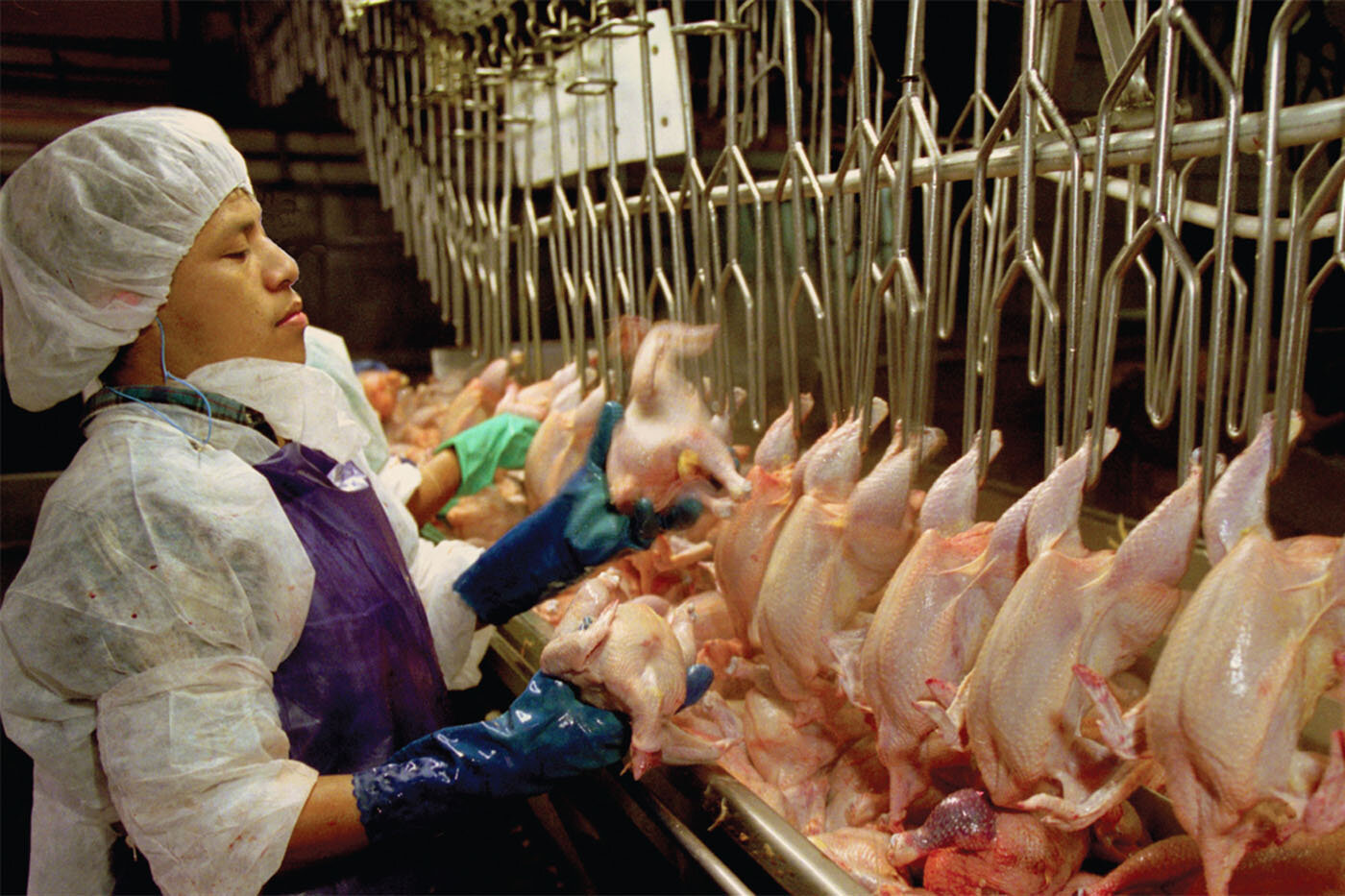Workers Fear Injury as Administration Clears Way for Faster Chicken Slaughter
Late last month, the Trump administration cleared the way for chicken plants to increase their processing line speeds from 140 birds per minute to 175 birds per minute. The change deals a blow to workers and reverses the efforts of labor and animal welfare advocates, who fought to halt poultry line speed increases in 2014. It also indicates the administration will likely soon remove line speed limits in hog slaughter and lower workplace injury reporting requirements throughout all sectors of the economy.
“This decision and the ones we expect are coming up is the pattern of the Trump administration to be cutting back on protections for workers and making decisions in favor of corporations rather than working people,” says Joann Lo, Co-Director of the Food Chain Workers Alliance.
The change comes in response to a 2017 petition to the Food Safety and Inspection Service by the National Chicken Council, the lobbying group representing poultry corporations. While FSIS denied the NCC’s request to lift all poultry line speeds, the USDA agency announced in January that they would set criteria by which poultry processors could apply for waivers to increase their line speeds to 175 birds per minute. FSIS released those criteria in February and published their final guidelines and public response to comments on September 28th. The agency is accepting applications for waivers.
Working conditions in poultry processing are already extremely hazardous. According to the Department of Labor, workers in meat processing plants are injured five times more frequently than all other private workers and are nearly twenty times more likely to develop carpal tunnel syndrome. But true injury rates are likely even higher, as studies by the Government Accountability Office suggest that federal data does not capture all meat processing injuries. One reason is that an estimated 28 percent of meat processing workers are foreign-born, and these workers are less likely to report injury or workplace misconduct due to fear of retaliation or deportation.
Surveys by the Southern Poverty Law Center and Food Chain Workers Alliancefound that at least two-thirds of poultry workers suffered significant work-related injuries, dwarfing officially reported injury rates.
“Immigrants and refugees are being taken advantage of,” says Mark Lauritsen, director of the United Food and Commercial Worker’s Food Processing, Packing and Manufacturing Division. Indeed, powerful meatpacking corporations have long been able to leverage their position as one of few employers in a given region to drive down wages and working conditions. This exploitation disproportionately affects marginal communities, as 62 percent of all meatpacking workers are people of color.
Higher line speeds are a main cause of these dangerous conditions. At current speeds, poultry workers perform the same repetitive motions 20,000 to 30,000 times a day, often wielding knives in close quarters, increasing the risks of musculoskeletal disorders and accidental cuts. There is so much pressure to keep a constant work pace that workers are often denied breaks, to the point that some wear diapers.
The new 175 birds per minute rate applies to the fastest and partially automated portion of the slaughter process, called the evisceration line. The poultry industry contends that increasing these speeds “would not be expected to have a significant impact on worker safety.”
However, labor advocates say that faster speeds in one portion of processing clearly affect workers downstream. “They’ll have 30 more birds a minute stockpiling up, that’s more chicken to be processed, but there’s not a lot of space in many of these locations to add extra workers,” explains Lauritsen. “Already there’s not enough workers there to safely do the job, so even if you went from 140 to 150 … that pace is already dangerous and by adding just one more bird it’s going to make it that much more dangerous.”
In fact, there are no limits on processing speeds in the cutting and deboning portions of the line, which require the most labor. Existing line speed limits are set by FSIS and focus on food safety and inspection requirements. The Occupational Safety and Health Administration (OSHA) oversees worker safety rules. The agency has set maximum operating speeds in some industries, like grain processing, but not in meatpacking.
OSHA denied a 2013 petition requesting the agency set slaughterhouse speed standards on the grounds that they did not have the resources to study the issue.
The Trump administration’s decision to approve poultry line speed increases, despite vocal pushback, does not bode well for their expected decision on hog line speeds. The USDA has proposed lifting all caps on hog processing speeds, which are currently limited to 1,100 hogs an hour. The proposed rule drew over 83,500 public comments, and a recent USDA statement said: “many of the comments requested that FSIS withdraw the proposal.”
Additionally, in July OSHA proposed new rules that would lower workplace injury reporting requirements, allowing corporations to submit less detailed records of injuries. If approved, the rules could further obscure the full picture of working conditions and dangers, increasing the gap between reported injuries and reality.


